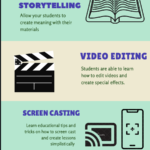- How will your interactive learning resource specifically ensure that the needs of all learners can be met?
As prospective teachers, it is our job to create an environment for students to feel confident and are successful in meeting their learning outcomes and goals. In our interactive learning resource, accommodations, scaffolds, and inclusivity will be a priority to ensure the student’s collective learning opportunities and achievement are not hindered. Implementing these objectives for the classroom will not only help the students who require it, as it will benefit the entire classrooms learning achievement (Meyer et al, 2014).
In our resource, we have provided several UDL guidelines that will provide students with accommodations to aid their Language Arts (descriptive language) learning needs. A Univeral Design for Learning (UDL) is the idea of eliminating barriers and restructuring the limitations in one’s environment to ensure maximum learning and support for students (CAST, 2018). Firstly, our group wants to ensure that all students have been giving school material in their dominant language. We will provide a translation script for any student who wants or needs another language script as well as an ASL script for students who are deaf or have a hearing impairment. Secondly, our group provides alternatives for audio and visual notes, through the creation of anchor charts. Essentially, we will be providing both audio and visual cues for students with sensory and perceptual disabilities. This UDL also benefits all students according to the dual-coding theory, as well as individuals process visuals material faster and more efficiently than audio or text material (Lynch, 2017). Lastly, our group is providing an accessible toolkit to all students to allow them to be more comfortable relaying what they know. This means that students have the opportunity to implement writing, typing, auditory components to compose and communicate what they have learned. All in all, these UDL guidelines that we have chosen to include in our Interactive Learning Resource will provide students will accommodations and reduce barriers, ensuring that students are reaching their maximum learning potential.
In addition to this, our design will encourage inclusion and provide equitable learning goals, for students to feel comfortable and support to amplify their learning. Our design focuses on cognitivism, however, embeds areas of constructivism and behaviorism to make certain that all students are gaining information to their full extent. In teaching, it is also a good idea to include areas of multimedia designs and principles to gain students’ attention and increase motivation. Our activities and assignments use scaffolding– supportive steps that are temporarily added to help build understanding–and create progressions for students to feel confident in their ability and knowledge retention.
Overall, our Interactive Learning Design focuses on increasing the student’s descriptive language abilities. When teaching concepts it is a priority to create support and accommodation for student inclusion and ample success. Therefore, one reduces barriers and allows students to meet their learning needs and deepen their understanding of the material. I believe that there is always more one can prepare for inclusion, however, it is easier to assess students learning needs when present in the classroom.
References:
Meyer, Anne, et al. (2014). Universal Design for Learning: Theory and Practice. CAST Professional Publishing, an Imprint of CAST, Inc. Retrieved from: udltheorypractice.cast.org/
CAST (2018). Universal Design for Learning Guidelines version 2.2. Retrieved from http://udlguidelines.cast.org
James, H. (2021). What Is Learning? Learning Design I. https://edtechuvic.ca/edci335/what-is-learning/
Lynch, M. (2017, November 7). How Digital Storytelling Can Amplify Your Students’ Voices. Retrieved November 14, 2017.



